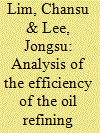| Srl | Item |
| 1 |
ID:
176796


|
|
|
|
|
| Summary/Abstract |
This study investigated the efficiency of the oil refining industry using the two-stage method of Markowitz portfolio optimization theory and panel data analysis of about 30 OECD countries from 2005 to 2016, which is a new methodology for measuring the efficiency of the oil industry. The oil refining industry's efficiency is derived from the prices of petroleum products (Naphtha, Gasoline, Kerosene, Diesel, and Fuel Oil) using the portfolio theory. The panel data was constructed using the following dependent variables, the crude oil production efficiency, energy consumption, renewable energy consumption, and R&D investment. Using the panel data analysis, empirical analyzes are conducted on how the efficiency of the oil refining industry is affected by explanatory variables. The results show that crude oil production and energy use in OECD countries have a negative effect on the efficiency of the oil refining industry, and consumption of renewable energy and R&D investment have a positive effect. Contrary to conventional perception, the petroleum industry can coexist with the renewable energy industry for sustainable development.
|
|
|
|
|
|
|
|
|
|
|
|
|
|
|
|
| 2 |
ID:
190831


|
|
|
|
|
| Summary/Abstract |
This study presents an analysis of the intra-regional performance of South Asian economies in terms of their productive efficiency during the period 1985–2019. A window data envelopment analysis (dea) based technique with bootstrapping is used to model the production frontier for seven South Asian economies to estimate their efficiency levels. The results show substantial differences in technical efficiency levels across South Asian economies and thus, the existence of vast potential to catch up with the best practices is revealed among these economies. On an average, the extent of technical inefficiency in south asia is about 46.92% per annum after adjusting for statistical bias. This is indicative of a huge gap in laggard and best practices within region. Both managerial and scale components of efficiency performance are equally responsible for observed production inefficiency in south asia. The existence of managerial inefficiency reflects failure of policy planners among affiliate countries to catch-up the best practices within South Asian region. However, the observed scale inefficiency (SIE) is because of the dominance of scale economies over diseconomies that urges need of enlarging cooperation among member nations.
|
|
|
|
|
|
|
|
|
|
|
|
|
|
|
|
| 3 |
ID:
126542


|
|
|
|
|
| Publication |
2013.
|
| Summary/Abstract |
This paper studies how the vertical structure of the electricity industry affects the social welfare when the incumbent has a cost advantage in generation relative to the entrants. The model consists of a generation sector and a transmission sector. In the generation sector the incumbent and entrants compete in a Cournot fashion taking as given the access charge to the transmission network set in advance by the regulator to maximize the social welfare. Two vertical structures, integration and separation, are considered. Under vertical separation the transmission network is established as an organization independent of every generator, whereas under vertical integration it is a part of the incumbent's organization. The optimal vertical structure is shown to depend on the number of entrants. If the number of entrants is smaller than a certain threshold, vertical separation is superior in welfare to vertical integration, and vice versa. This is because the choice of vertical structure produces a trade-off in the effects on competition promotion and production efficiency. If a break-even constraint is imposed in the transmission sector, however, vertical integration is shown to be always superior in welfare.
|
|
|
|
|
|
|
|
|
|
|
|
|
|
|
|
| 4 |
ID:
142107


|
|
|
|
|
| Summary/Abstract |
This article analyses factors influencing rural households’ decisions to remain in collectives or separate from them during Russia’s post-socialist privatisation period in the 1990s. It argues that although decisions to remain in or separate from a collective were influenced by a number of factors, the dominant one was the households’ abilities to cope with independent production. These abilities were predetermined by the extent to which production was intensified in each collective. In Siberia less labour and capital intensive husbandry based on native herding that is well - adapted to the local environment, offered better chances of establishing viable economies, and thus greater incentives to split from a collective.
|
|
|
|
|
|
|
|
|
|
|
|
|
|
|
|